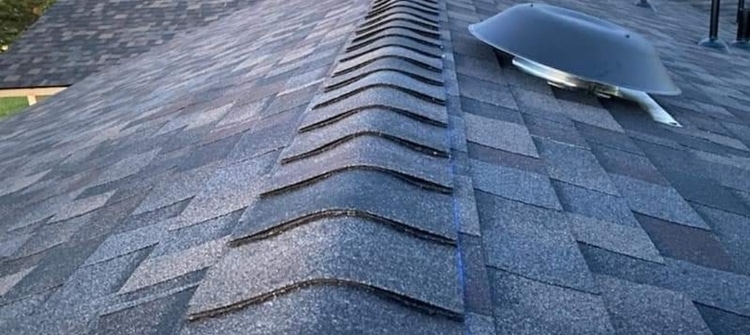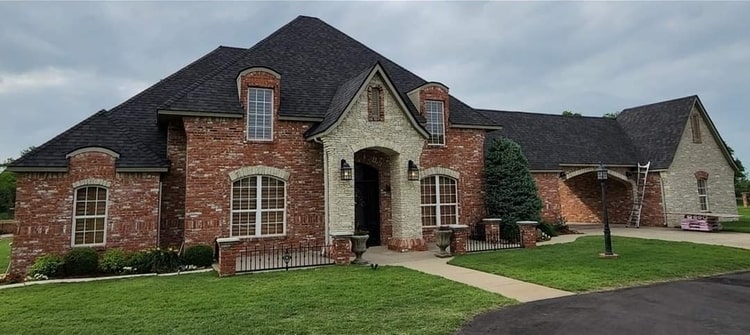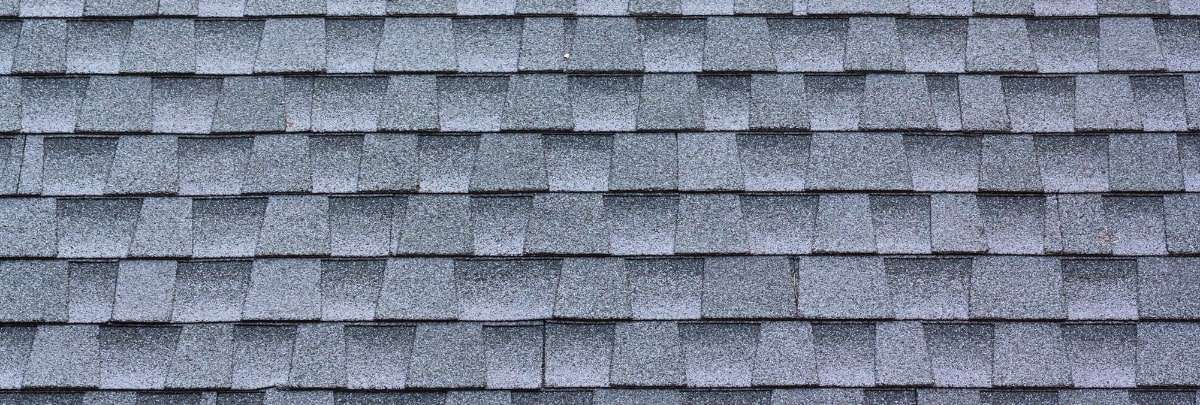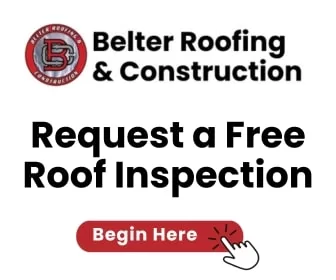Oklahoma’s unique climatic challenges, ranging from intense sun and heat to sudden, severe storms, pose particular concerns for homeowners, especially regarding roofing.
In this comprehensive guide, we’ll explore the lifespan of shingle roofs in Oklahoma, factors that influence durability, maintenance tips to extend your roof’s life, and signs that it’s time to consider an Oklahoma roof replacement.
Understanding Shingle Roofs in Oklahoma’s Climate
Oklahoma’s extreme variability makes its weather notably harsh on various roof types. The state experiences hot, humid summers and cold, sometimes icy winters, not to mention the potential for severe weather events such as tornadoes and hailstorms.
Let’s take a look at how these conditions affect shingle roofs.

Impact of Sun and Heat on Asphalt Shingles
While popular and cost-effective, asphalt shingles face significant challenges under the intense sun and temperatures typical of Oklahoma summers. The UV rays and the heat can accelerate wear and tear, leading to various issues over time.
Here, look at how sun and heat impact asphalt shingles and which types are best equipped to handle this exposure:
General Effects of Sun and Heat
- Drying Out: UV rays can cause the oils in asphalt shingles to dry out, making them brittle and more prone to cracking.
- Curling: As shingles expand and contract with temperature changes, the edges may begin to curl upward, making them less effective at shedding water and more susceptible to wind uplift.
- Granule Loss: The granules that cover asphalt shingles protect them from UV damage. Over time, heat can cause these granules to loosen and wash away, reducing the shingle’s resistance and speeding up the aging process.
Types of Asphalt Shingles Resistant to Sun and Heat
- Fiberglass Asphalt Shingles: These have a fiberglass mat that provides better heat resistance than traditional organic mat-based shingles. Fiberglass shingles are less likely to soften under extreme heat, maintaining their shape and effectiveness.
- Cool Roof Shingles: Specifically designed to reflect more sunlight and absorb less heat, cool roof shingles are made with specially coated granules that help reflect UV rays. These shingles can help reduce your roof’s temperature by up to 50 degrees, significantly reducing heat-related degradation.
- Architectural Shingles: Thicker than standard 3-tab shingles, they offer better durability and are less prone to sun damage due to their multi-layer construction. They also provide a more prosperous, dimensional look that can enhance your home’s aesthetic appeal.
Strategies to Enhance Resistance
- Proper Installation: Ensure that shingles are installed with adequate overlap and appropriately secured to minimize exposure to the elements and prevent edges from lifting.
- Regular Maintenance: Inspect your roof regularly for signs of sun damage, such as curling and granule loss. Early detection can lead to repairs that extend the lifespan of your roof.
- Ventilation Improvements: Adequate attic ventilation can help lower roof temperatures by allowing heat to escape, which reduces the thermal stress on your shingles.
Effects of Rain and Hail on Asphalt Shingles
In Oklahoma, where storms are a regular occurrence, asphalt shingles must withstand not only rain but also the potentially damaging impacts of hail.
Understanding how these weather conditions affect asphalt shingles can help homeowners make more informed choices about roofing materials and maintenance strategies.
Water Damage Concerns
- Moisture Penetration: If shingles are not correctly installed or become damaged, water can seep underneath them, leading to leaks, rot in the roofing deck, and mold and mildew growth.
- Lifting and Curling: Continuous exposure to water, especially when coupled with high winds, can cause shingles to lift and curl. This allows further water infiltration and increases the risk of shingles being blown off during storms.
Hail Damage Dynamics
- Surface Impact: Hail can create immediate physical damage to shingles, such as punctures, cracks, or knocked-off granules. This exposure strips the shingles of their protective layer, making them more vulnerable to UV rays and subsequent weathering.
- Granule Loss: The granules on the surface of asphalt shingles serve as a barrier against UV light and physical impacts. Hail can dislodge these granules, reducing the shingle’s lifespan and effectiveness.
- Bruising: Sometimes, hail doesn’t break shingles outright but causes bruising, weakening the shingle structure over time and leading to deterioration.
Types of Asphalt Shingles for Better Hail Resistance
- Impact-Resistant Shingles: These are specially designed to withstand the impact of hailstones without sustaining significant damage. Classified under UL 2218 as Class 1 to 4, with Class 4 being the most resistant, these shingles are made from modified asphalt, which provides greater flexibility and durability.
- Architectural Shingles: Thicker and more durable than the standard 3-tab shingles, architectural shingles are better able to absorb the impact of hail without sustaining significant damage.
Maintenance and Prevention Tips
- Regular Inspections: Especially after storms, inspect your roof for any signs of hail or water damage. Look for missing granules, cracked shingles, or areas with pooling water.
- Prompt Repairs: Addressing damage quickly can prevent minor issues from becoming significant leaks. Replace cracked or missing shingles and repair any lifted edges.
- Proper Installation: Ensure that your asphalt shingles are installed correctly with adequate flashing and underlayment, which can help prevent water from penetrating the roof structure.
- Gutter Maintenance: Keep gutters and downspouts clear to ensure water is effectively channeled away from the roof, reducing the risk of water damage.


Wind and Tornado Considerations for Asphalt Shingles
Oklahoma’s location in Tornado Alley necessitates roofing materials, especially asphalt shingles, to withstand high winds and occasionally violent tornadoes.
Below, we explore how different types of asphalt shingles perform under these conditions and what can be done to enhance their wind resistance.
Challenges Posed by High Winds
- Shingle Lifting: Strong winds can get under the edges of shingles and lift them from the roof, exposing the underlayment or even the roof deck to the elements.
- Adhesive Failure: Wind can cause the adhesive strip that bonds shingles together to fail, leading to shingle blow-off during extreme weather.
- Edge Curling: Over time, wind can cause the edges of shingles to curl upwards, reducing their effectiveness in sealing out water and increasing the risk of further wind damage.
Types of Asphalt Shingles and Their Wind Resistance
- 3-Tab Shingles: These are the most basic form of asphalt shingles and are rated for wind speeds up to about 60-70 mph. They are less expensive but less resistant to high winds than other types.
- Architectural Shingles are thicker and heavier than 3-tab shingles. They are designed to withstand higher wind speeds, typically up to 110 mph, and their multi-layer construction provides additional strength and durability.
- High-Wind Rated Shingles: Some asphalt shingles are specifically manufactured to resist even higher wind speeds, up to 130 mph or more. These shingles feature enhanced adhesive capabilities and a more rigid construction to meet the demands of wind-prone areas like Oklahoma.
Installation and Maintenance Tips to Enhance Wind Resistance
- Proper Nailing: Shingles should be nailed down correctly and according to manufacturer guidelines, typically with four to six nails per shingle, to help prevent lifting and blow-off during high winds.
- Sealant Strips: Applying additional roofing cement under the edges of shingles can help to secure them against wind uplift.
- Regular Roof Inspections: Inspect your roof regularly, especially after significant weather events, to ensure that there are no loose or damaged shingles that could become vulnerable in future storms.
- Edge Metal Strips: Installing metal strips along the roof edges can help anchor the shingles down, providing an extra layer of wind resistance.
- Professional Installation: Consider hiring certified professionals who specialize in high-wind roofing systems. Their expertise can ensure that your roof is optimized for wind resistance.
Average Lifespan of Shingle Roofs in Oklahoma
The lifespan of a shingle roof in Oklahoma can vary significantly based on material quality, installation standards, and ongoing maintenance. Here’s what Oklahoma homeowners can typically expect.
Asphalt Shingles: The Popular Choice
Asphalt shingles remain the preferred roofing material for many Oklahoma homeowners because of their lower replacement cost and adequate durability in diverse weather conditions.
Why Choose Asphalt Shingles?
- Cost-Effectiveness: Asphalt shingles are among the most economical roofing options available. Their lower cost covers the initial purchase and the installation, as they are easier and quicker to install than other materials like metal or tile.
- Versatility: Available in various colors and styles, asphalt shingles can be easily adapted to match different home aesthetics. Whether it’s a traditional look with 3-tab shingles or a more sophisticated appearance using architectural shingles, a style suits any home.
- Ease of Repair: Unlike other roofing materials that may require specialized skills to fix, asphalt shingles can be easily replaced if damaged. This makes maintenance more straightforward and often less costly.
Average Lifespan in Oklahoma
- General Expectancy: The typical lifespan of asphalt shingles ranges from 15 to 30 years. Several factors, such as Oklahoma’s climate and environmental conditions, can influence this range.
Environmental Factors
- Sun Exposure: The intense Oklahoma sun can prematurely age shingles by breaking down the asphalt binder and causing the protective granules to loosen and fall off.
- Temperature Swings: Frequent and drastic temperature changes between seasons can cause shingles to expand and contract, weakening their structure over time and leading to issues such as cracking or blistering.
- Severe Weather: Strong winds, hail, and heavy rains expected in Oklahoma can physically damage shingles and shorten their effective lifespan.
Enhancing Durability Through Care and Maintenance
- Regular Inspections: Biannual inspections by a professional can help catch and address potential issues early, such as lifting shingles or granule loss, before they necessitate significant repairs or total replacement.
- Proactive Repairs: Properly repairing roof damage after weather events can prevent minor issues from worsening. This includes replacing missing shingles and fixing leaks.
- Adequate Ventilation: Proper attic ventilation prevents heat and moisture buildup underneath the shingles, reducing the risk of rot and mold that could weaken the roof structure.
- Debris Management: Keeping the roof free of debris, such as leaves and branches, can prevent water pooling and ensure that moisture drains off properly, which is critical to avoiding water damage.
Higher-End Shingles: A Worthy Investment?
While basic 3-tab asphalt shingles are standard for their affordability and straightforward installation, upgrading to higher-end options like architectural and composite shingles can provide significant advantages. These premium choices not only enhance the look of your home but also offer improved durability and a longer lifespan.
Here’s a closer look at these high-quality shingle types and why they might be a wise investment for Oklahoma homeowners.
Architectural Shingles
- Enhanced Durability: Architectural shingles are constructed with multiple layers of asphalt, making them thicker and more robust than standard 3-tab shingles. This design provides excellent wind uplift, tearing, and debris penetration resistance.
- Aesthetic Appeal: These shingles come in various textures and colors, mimicking the appearance of natural wood or slate without the associated maintenance or cost. Their dimensional look can significantly boost curb appeal and potentially increase home value.
- Longer Lifespan: Your Oklahoma roof’s lifespan should be considered when installing a new roof. Typically, architectural shingles have a lifespan of 25 to 30 years, which is longer than the 15 to 20 years expected from 3-tab shingles. Some high-quality brands offer warranties extending up to 50 years.
- Wind Resistance: They are rated to withstand higher wind speeds, often up to 110 mph, with some specially designed versions resistant to even higher speeds, making them suitable for Oklahoma’s storm-prone weather.
Composite Shingles
- Superior Material Blend: Composite shingles are made from fiberglass, recycled paper products, and asphalt. This combination strongly resists physical impacts and weathering, which is critical in varying climates like Oklahoma’s.
- Maintenance and Eco-Friendliness: These shingles are easier to maintain than organic materials and are often made from eco-friendly or recycled materials, appealing to environmentally conscious homeowners.
- Impact and Fire Resistance: Composite shingles resist hail and other impacts. They are also less likely to catch fire than organic options, providing an added layer of safety.
- Longevity and Warranty: Composite shingles’ lifespans can exceed 30 years, and many manufacturers offer extensive warranties that guarantee durability and performance.
Considerations for Investment
- Cost vs. Return: While architectural and composite shingles cost more upfront than 3-tab shingles, their extended durability and minimal maintenance needs can lead to lower long-term costs. The potential increase in property value and curb appeal can offset the initial investment.
- Installation: Professional installation is crucial, especially for these high-grade shingles, to realize all potential benefits. Incorrect installation can negate durability features and void warranties.
- Climate Suitability: Given Oklahoma’s severe weather conditions, investing in shingles that can handle high winds, hail, and UV exposure is a practical choice to reduce the frequency and cost of repairs or replacements.


Maintenance Tips to Extend Your Roof’s Life
Taking good care of your asphalt shingle roof is essential, particularly in Oklahoma, where the weather can be harsh. Proper maintenance can not only extend the lifespan of your roof but also prevent costly repairs. Here are some practical steps homeowners can take to maintain their asphalt shingle roofs:
Regular Inspections
- Importance of Professional Inspections: Regular checks by a professional are crucial because they can spot issues you might miss. Problems like minor leaks or damage from debris can become serious if left unaddressed.
- What Inspections Should Include:
- Checking for Missing or Damaged Shingles: Ensuring all shingles are intact and securely attached.
- We are examining Sealant and Flashing: Looking for cracks or breaks that could lead to leaks.
- Inspecting for signs of algae or mosquitos: These can cause shingle degradation if not cleaned.
- Evaluating Ventilation: Poor attic ventilation can lead to heat buildup, damaging shingles over time.
- Inspecting Gutters and Downspouts: Ensuring they are clear of debris to prevent water from backing up onto the roof.
Cleaning and Repair
- Keeping the Roof Clean:
- Remove Debris: Leaves, branches, and other debris can accumulate and retain moisture, which might lead to mold and mildew growth.
- Clean Gutters Regularly: Blocked gutters can cause water to pool, increasing the risk of leaks.
- Guidance on Repairs:
- Promptly Replace Damaged Shingles: To prevent water from seeping through and causing structural damage.
- Seal Leaks: To prevent water ingress, use roof cement or caulk to seal around chimneys, vents, and other roof protrusions.
- Recognize Repair Needs: Look for missing granules, cracked shingles, or shingles that appear wet or darker than nearby areas, indicating potential issues.
Preventative Measures
- Trimming Overhanging Branches: Branches that hang over the roof can scrape and damage shingles during high winds and drop debris that accumulates on the roof.
- Installing Adequate Attic Insulation and Ventilation:
- Insulation: Helps regulate the temperature in the attic, preventing winter ice dams and reducing summer heat.
- Ventilation: Proper airflow keeps the attic temperature consistent, reducing the potential for heat damage and helping moisture escape, which prevents rot and mold growth.
- Regular Maintenance of Flashing: Flashing around chimneys, vents, and where the roof meets walls should be checked and repaired, as these are vulnerable points for leaks.
- Apply a Protective Sealant: Consider applying a UV-resistant sealant to help protect the shingles from sun damage and extend their life.
When to Replace Your Shingle Roof
Knowing when to replace your roof is crucial for keeping your home safe and secure. A failing roof can lead to severe issues, from water damage inside your home to compromised structural integrity.
Age of the Roof
- Typical Lifespan: Most asphalt shingle roofs are designed to last between 15 and 30 years, depending on the shingle quality, climate, and maintenance history. If your roof is approaching or has surpassed this age range, it’s wise to consider replacement.
- Inspection is Key: As your roof ages, it’s essential to increase the frequency of inspections. A professional can assess whether the aging roof still has a few good years left or if it’s time to plan for a replacement. Aging roofs may not handle stress from storms or extreme temperatures well, making them more damage-resistant.
Visible Damage
- Curling or Buckling Shingles: This indicates that the shingles are past their life expectancy or were improperly installed. Curled or buckled shingles are more likely to leak or be ripped off by wind.
- Missing Shingles: Gaps in your shingle coverage significantly increase the risk of structural damage from water.
- Cracked Shingles: Cracked shingles are typically caused by wind damage and are a clear sign that the shingles are failing.
- Granule Loss: Check the gutters and downspouts; an accumulation of granules there suggests that your shingles are wearing out and losing their weatherproofing effectiveness.
- Moss and Algae Growth: While this might be more cosmetic, extensive growth can retain moisture and lead to roof material degradation over time.
Performance Issues
- Leaks: Frequent leaks are a primary indicator that your roof system may fail. Regular patches might not be enough if leaks become recurrent or widespread.
- Daylight Through the Roof Boards: If you can see the sky from your attic, some holes could lead to significant water ingress.
- Sagging: This is a serious sign that there is likely structural damage, either from sustained water ingress or from structural failure. A sagging roof is at high risk of collapse and should be addressed immediately.
- Increased Energy Bills: If your heating or cooling costs increase unexplainedly, it might be due to poor insulation and ventilation, often exacerbated by an old or failing roof.
If you notice any of these issues, contacting a roofing professional for a thorough inspection is crucial. In many cases, early intervention can prevent higher costs down the line. Waiting too long to replace a failing roof can lead to more extensive damage, not only to the roof itself but also to the interior of your home.
Frequently Asked Questions About Shingle Roofs (FAQs)
Here are a few common roofing questions referring to shingle roofs in Oklahoma:
What is the best type of shingle for Oklahoma's weather?
Architectural shingles are typically the best choice for Oklahoma’s varied and often harsh weather conditions. These shingles are designed to withstand high winds, hail, and significant temperature changes, making them ideal for the state’s climate. They are thicker and more durable than standard 3-tab shingles, offering better resistance to wind uplift and debris impact. Additionally, impact-resistant shingles, rated Class 4 for hail resistance, can be a wise investment for areas particularly prone to severe weather.
How often should I inspect my shingle roof in Oklahoma?
Inspecting your shingle roof at least twice a year—once in the spring and once in the fall is recommended. These inspections can help catch potential problems early, such as storm damage or general wear and tear. Additionally, it’s wise to check your roof after any significant weather event, such as a severe storm or tornado, which is common in Oklahoma.
Can I replace the damaged shingles, or should I hire a professional?
While minor repairs, like replacing a few damaged shingles, can be a DIY project if you have the right tools and safety equipment, it is generally recommended to hire a professional. Roofing can be dangerous work, and improper installation can lead to more significant problems, including leaks and further damage. Professionals have the experience and equipment to safely and effectively repair or replace roofing materials.
What are the signs that my shingle roof is failing?
Signs that your shingle roof may be failing include:
- Frequent and unexplained leaks
- Missing, cracked, or curled shingles
- Granules from shingles accumulating in gutters
- Sagging areas on the roof
- Daylight visible through the roof boards in the attic
- Moss or algae growth that is excessive and hard to remove
These signs indicate that the roof is nearing the end of its useful life and may need to be replaced.
How much does it typically cost to replace a shingle roof in Oklahoma?
The cost of replacing a shingle roof in Oklahoma can vary widely depending on the size, the type of shingles used, and the job’s complexity. On average, homeowners might expect to pay between $5,000 and $10,000+ for a complete shingle roof replacement. Premium materials, such as architectural or impact-resistant shingles, may increase the cost, as will additional features like enhanced underlayment or unique treatments for algae resistance.
Maximizing Home Value and Protection: The Benefits of Choosing the Right Shingle Roof in Oklahoma
Choosing the right shingle roof in Oklahoma is not just about covering your home; it’s about protecting your investment and enhancing your property’s value. With the state’s extreme weather conditions, from scorching heat waves to fierce tornadoes, selecting a durable, weather-resistant roofing material that cannot be overstressed is essential.
Architectural and impact-resistant shingles, recognized for their resilience against harsh weather, offer homeowners in Oklahoma both peace of mind and a significant boost in curb appeal.
Furthermore, regular maintenance and timely inspections are essential to extend the life of your roof and prevent costly repairs. Whether considering a new installation or needing a replacement, understanding the signs of roof failure and responding promptly can save you from further financial burdens.
While the upfront cost of a higher-quality shingle might be more significant, the long-term savings in maintenance and energy efficiency can be substantial. For those looking to make environmentally friendly choices, seeking local incentives for energy-efficient roofing can also provide financial benefits.
Ultimately, the right roof goes beyond mere aesthetics—it’s a critical component that shields your home, enhances its market value, and provides a safe shelter for years to come.
Rely on a Licensed Oklahoma Roofing Expert
A licensed roofing professional in Oklahoma can accurately determine if your roof needs minor fixes, significant roof repairs, or a complete replacement. When installing, repairing, or replacing shingle roofs and general roof maintenance, it is essential to trust a specialist with a robust background in residential and commercial roofing systems.
Hiring an experienced contractor brings many benefits, one of the most valuable being peace of mind. Belter Roofing, a reputable roofing expert committed to serving the Oklahoma community since 2015, offers extensive expertise in various roofing materials. They consistently maintain detailed records of all projects to ensure quality and consistency.
Opting for professionals such as Belter Roofing means receiving repair or replacement services and ensuring that every roof component is meticulously managed. Their comprehensive understanding of roofing nuances guarantees that your home will be well-protected for the foreseeable future. Don’t hesitate to use their help to safeguard your home against the elements.
Let's Have a Conversation
Table of Contents
- Understanding shingle roofs
- The impact of sun and heat
- The effects of rain and hail
- Wind and tornado considerations
- Average lifespan of a shingle roof
- Are higher-end shingles worth it?
- Maintenance tips
- When to replace your roof
- Frequently asked questions
- Maximizing your home’s value
- Rely on a professional roofer
Share this Article


